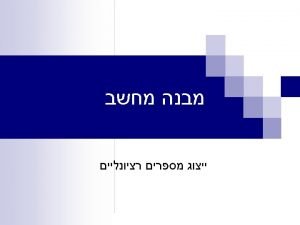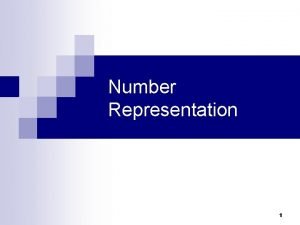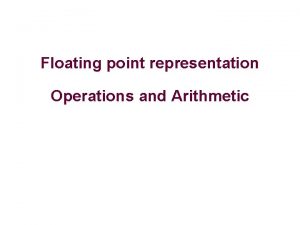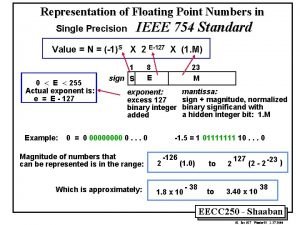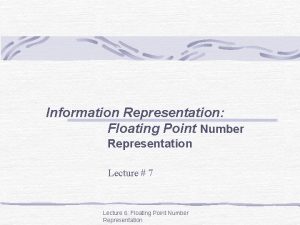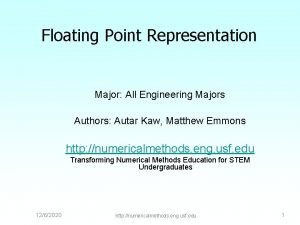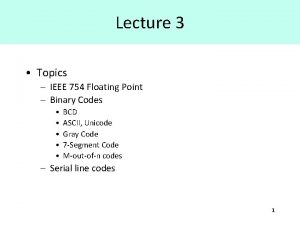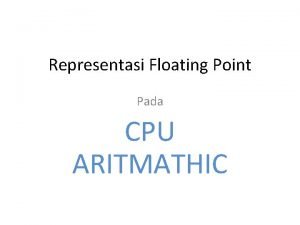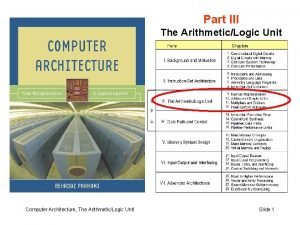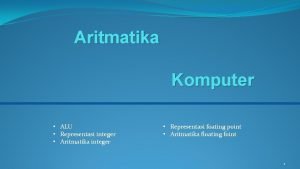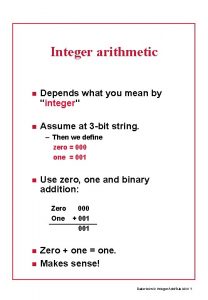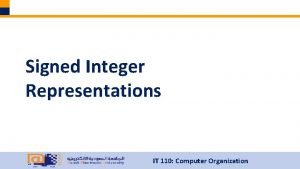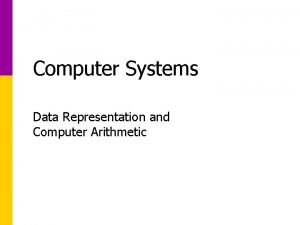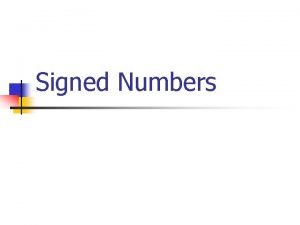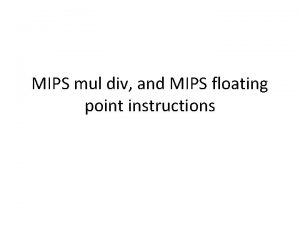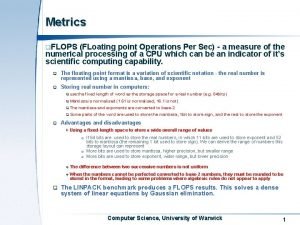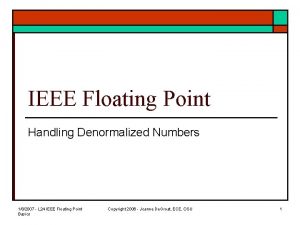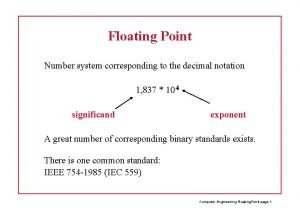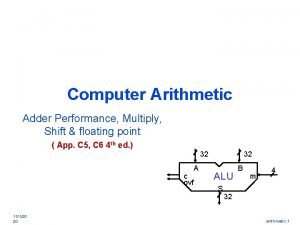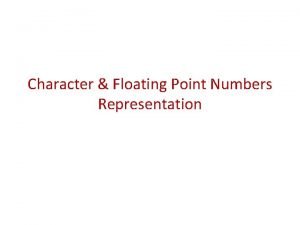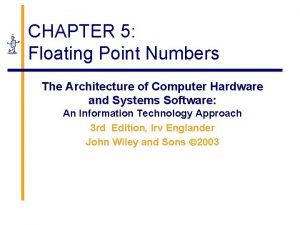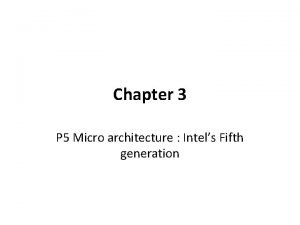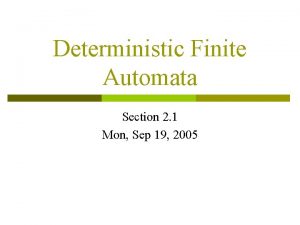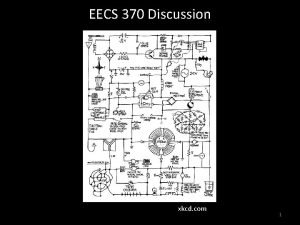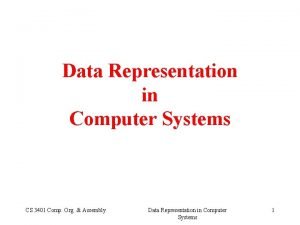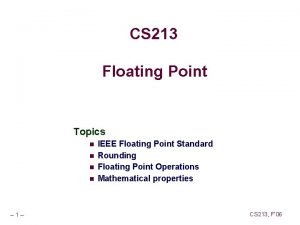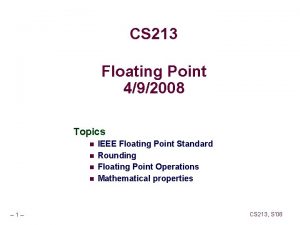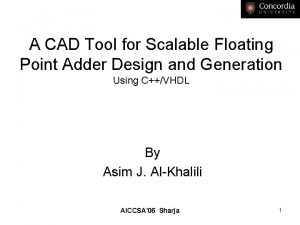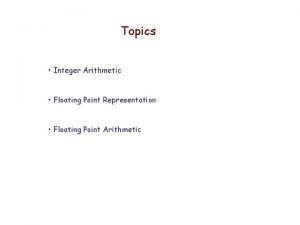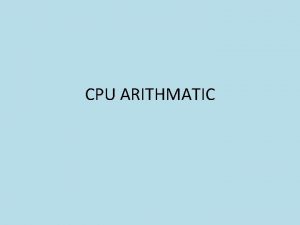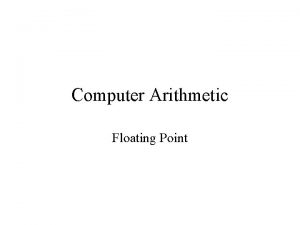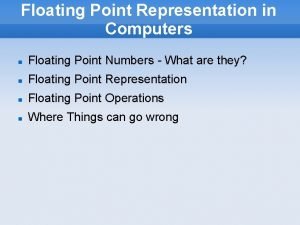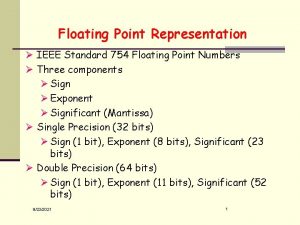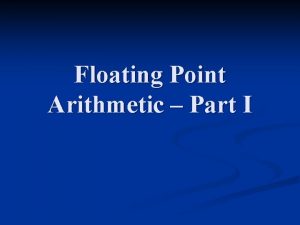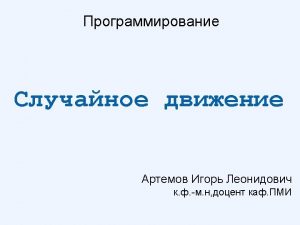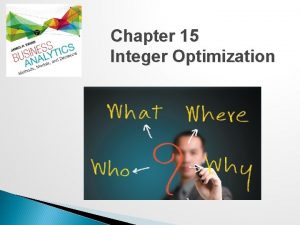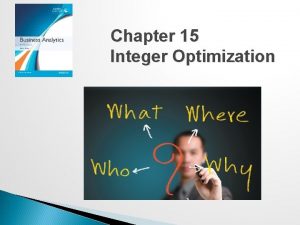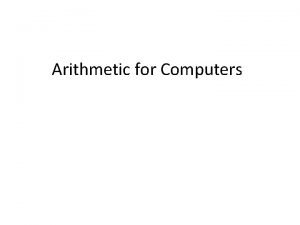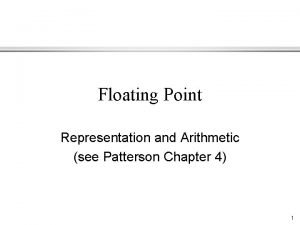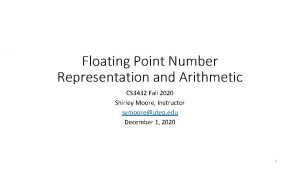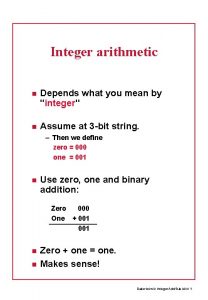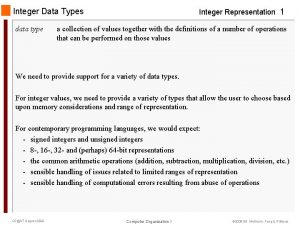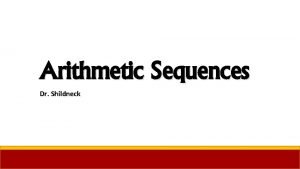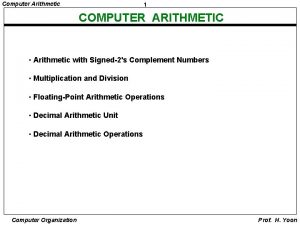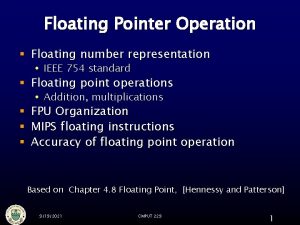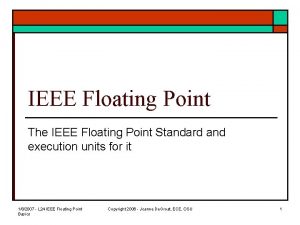Topics Integer Arithmetic Floating Point Representation Floating Point































- Slides: 31

Topics • Integer Arithmetic • Floating Point Representation • Floating Point Arithmetic

2’s Complement Integers

2’s Complement Addition/Subtraction A+B A What is Overflow? How is it identified?

Unsigned Integer Multiplication

Unsigned Integer Multiplication Q x M AQ

Unsigned Integer Multiplication Flow Diagram

2’s Comp Multiplication Booth’s Algorithm Add one extra bit to the Q register: Q-1

2’s Comp Multiplication Booth’s Algorithm Q-1

2’s Comp Multiplication Booth’s Algorithm

Booth : (7) x (3) A Q M 3 7 0000 0011 0 0111 ----------1001 0011 0 0111 1100 1001 1 0111 ---------- A <- (A - M) Shift 1 st 2 nd 1110 0100 1 0111 ----------0101 0100 1 0111 0010 1010 0 0111 ---------- Shift A <- (A + M) Shift 3 rd 4 th 0001 0101 0 0111 ---------- Shift

Booth : (7) x (-3) A Q M -3 7 0000 1101 0 0111 ----------1001 1101 0 0111 1100 1110 1 0111 ----------0011 1110 1 0111 0001 1111 0 0111 ----------1010 1111 0 0111 1101 0111 ---------- A <- (A - M) Shift 1 st A <- (A + M) Shift 2 nd A <- (A - M) Shift 3 rd 4 th 1110 1011 1 0111 ---------- Shift

Booth : (-7) x (3) A Q M 3 -7 0000 0011 0 1001 ----------0111 0011 0 1001 0011 1001 ---------- A <- (A - M) Shift 1 st 2 nd 0001 1100 1 1001 ----------1010 1100 1 1001 1101 0110 0 1001 ---------- Shift 1110 1011 0 1001 ---------- Shift A <- (A + M) Shift 3 rd 4 th

Booth : (-7) x (-3) A Q M -3 -7 0000 1101 0 1001 ----------0111 1101 0 1001 0011 1110 1 1001 ----------1100 1110 1 1001 1110 0111 0 1001 ----------0101 0111 0 1001 0010 1011 1 1001 ---------- A <- (A - M) Shift 1 st A <- (A + M) Shift 2 nd A <- (A - M) Shift 3 rd 4 th 0001 0101 1 1001 ---------- Shift

Unsigned Integer Division

Unsigned Integer Division

Unsigned Integer Division

Unsigned Integer Division Divisor M Dividend Q Quotient in Q Remainder in A

What about 2’s Comp Division ? • Can we do something like Booth’s Algorithm? • Why might we use Booth’s Algorithm for multiplication but not for Division?

Single Precision Floating Point Numbers IEEE Standard 32 bit Single Precision Floating Point Numbers are stored as: S EEEE FFFFFFFFFFFF S: Sign – 1 bit E: Exponent – 8 bits F: Fraction – 23 bits Significand The value V: • If E=255 and F is nonzero, then V= Na. N ("Not a Number") • If E=255 and F is zero and S is 1, then V= - Infinity • If E=255 and F is zero and S is 0, then V= Infinity • If 0<E<255 then V= (-1)**S * 2 ** (E-127) * (1. F) (exponent range = -127 to +128) • If E=0 and F is nonzero, then V= (-1)**S * 2 ** (-126) * (0. F) ("unnormalized" values”) • If E=0 and F is zero and S is 1, then V= - 0 • If E=0 and F is zero and S is 0, then V = 0 Note: 255 decimal = 1111 in binary (8 bits)

FP Examples

Double Precision Floating Point Numbers IEEE Standard 64 bit Double Precision Floating Point Numbers are stored as: S EEEEEE FFFFFFFFFFFFFFFFFFFFFFFFFF S: Sign – 1 bit E: Exponent – 11 bits F: Fraction – 52 bits Significand The value V: • If E=2047 and F is nonzero, then V= Na. N ("Not a Number") • If E=2047 and F is zero and S is 1, then V= - Infinity • If E=2047 and F is zero and S is 0, then V= Infinity • If 0<E<2047 then V= (-1)**S * 2 ** (E-1023) * (1. F) (exponent range = -1023 to +1024) • If E=0 and F is nonzero, then V= (-1)**S * 2 ** (-1022) * (0. F) ("unnormalized" values) • If E=0 and F is zero and S is 1, then V= - 0 • If E=0 and F is zero and S is 0, then V= 0 Note: 2047 decimal = 111111 in binary (11 bits)

32 bit 2’s Complement Integer Numbers All the Integers from -2, 147, 483, 648 to + 2, 147, 483, 647, i. e. - 2 Gig to + 2 Gig-1

32 bit FP Numbers

“Density” of 32 bit FP Numbers Note: ONLY 232 FP numbers are representable There are only 232 distinct combinations of bits in 32 bits !

The Added Denormalized FP Numbers

Floating Point Addition / Subtraction Steps: • Check for zero • Align the significands (fractions) • Add or Subtract the significands • Normalize the Result Bad Results: • • Exponent Overflow Exponent Underflow Significand Overflow Significand Underflow

Floating Point Addition/Subraction

Floating Point Multiplication 1) Check for zero 2) Multiply significands 3) Add exponents 4) Normalize Overflow/underflow?

Floating Point Multiplication

Floating Point Division 1) Check for zero 2) Divide significands 3) Subract exponents 4) Normalize Overflow/underflow?

Floating Point Division
 Integer number definition
Integer number definition Fixed point representation vs floating point
Fixed point representation vs floating point Floating point arithmetic examples
Floating point arithmetic examples Floating point arithmetic examples
Floating point arithmetic examples Floating point addition flowchart
Floating point addition flowchart Why use floating point numbers
Why use floating point numbers Floating point representation
Floating point representation Point format example
Point format example Floating point representation
Floating point representation Floating point representation definition
Floating point representation definition Aritmatika bilangan integer
Aritmatika bilangan integer Integer arithmetic
Integer arithmetic Signed integer representation
Signed integer representation Data representation and computer arithmetic
Data representation and computer arithmetic Floating point division algorithm in computer architecture
Floating point division algorithm in computer architecture Convert to floating point
Convert to floating point Mult mips instruction
Mult mips instruction Floating-point operations per second
Floating-point operations per second Denormalized float
Denormalized float Floating-point number
Floating-point number Fp adder hardware
Fp adder hardware Eascii
Eascii Parts of a floating point number
Parts of a floating point number Explain an instruction issue algorithm of pentium processor
Explain an instruction issue algorithm of pentium processor Xkcd floating point
Xkcd floating point Dfa for floating point numbers
Dfa for floating point numbers Xkcd floating point
Xkcd floating point Express (32)10 in the revised 14-bit floating-point model.
Express (32)10 in the revised 14-bit floating-point model. Floating point form
Floating point form Floating point puzzles
Floating point puzzles Floating point puzzles
Floating point puzzles Floating point adder vhdl
Floating point adder vhdl

